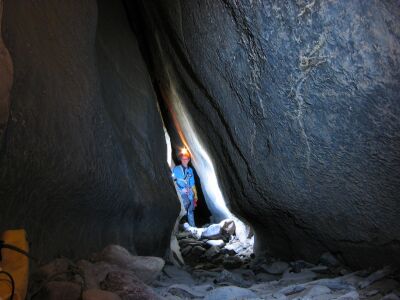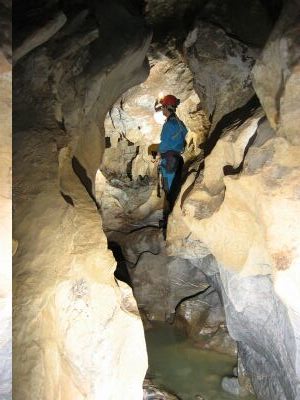AREA 34: Pho Bang
PB1:
Hang Ong
Development: 1523 m
Denivelation: -341 m
Hang Ong (Bee Cave) is a huge porch (more than 50 m wide, 20 m high)
slightly above the valley bottom which can easily be seen on the right,
across the valley from the new road going to Pho Bang. Giant blocks are
scattered along the floor, which inclines steeply towards the south. To
the east lies the first way on (described and surveyed separately).
Down, a small stream flows along the southern wall into a narrowing
gallery, still some 8 m wide, filled with large boulders and going down
steeply. One needs to find this way through the boulders twice before
arriving on top of the first pitch, P8. A horizontal gallery is
followed by a descent trough boulders after which the gallery becomes
more and more cave-like and meandering. A 6 m descent along sticky
sharp-weathered
rock, followed by a small window-like passage brings you to a small
chamber where the heading of the cave changes 180°. A major inlet
gives into this chamber, where one can see a section through an ancient
barrier of pebble deposits, a phenomenon that is observed at several
other locations in this cave. An easy, horizontal man-wide passage
starts from here and after a 3 m step gives onto a beautiful fault
which is followed over 60 m to end up in a wide chamber where the
streamlet reappears. Exploration stopped here on the first day at a
depth of 170 m. A climb down and a 3m step leads into the river,
flowing through a high but narrow fault-like passage. A 4 m cascade,
which required particular rigging in order to remain dry, gives into a
basin followed by a 3 m step. A 6m
pitch brings you to the bottom of a beautiful chamber with a shallow
basin, fed by a 3 m cascade. From here the cave starts heading
south-west in a wide meander through which the river is running
constantly. A 2 m cascade lies just behind a polished block jammed in
the passage and gives into a basin. Around the corner lies a deep and
wide basin with a dry part higher up on the right side, giving onto a 6
m pitch along a cascade. The canyon goes on and gives into a wider,
silent area, the ‘picture gallery’ where a lot of time was spent taking
photographs on the second day of the exploration. A deep basin is
followed by an easy passage ending on a 4m cascade at -250 m. The
aspect of the cave changes at a steeply inclined passage with r unning
water underneath two natural bridges. This passage is followed by a 6 m
cascade giving into a deep and long basin, where one can hardly stay
out of the water. The basin is followed by a narrow
passage
giving into
a little wet chamber with another 5 m cascade. A wider and dry passage
follows with a few formations, a rare phenomenon in this cave. Then the
meandering wet canyon
passage resumes, with 5 to 10 cm large calcite
crystals on the wall, giving onto a charming 4 m cascade.
A dry canyon
with sandy bottom departs at the top level of the cascade which was
explored for over 50 m in a straight line without reaching the end.
Down the cascade, during the fourth
day of exploration, the wet canyon
continues over a difficult 2 m step to arrive in a wide and quiet
place, contrasting to the noisy canyon. At -300 m, the passage gives on
top of a long slope with the ceiling running parallel at a height of
some 80 cm, along which the water runs down. This bizarre phenomenon is
probably shaped by the water that washed away one layer in between the
inclined strata and is still continuing its sawing action. Due to
unning
water underneath two natural bridges. This passage is followed by a 6 m
cascade giving into a deep and long basin, where one can hardly stay
out of the water. The basin is followed by a narrow
passage
giving into
a little wet chamber with another 5 m cascade. A wider and dry passage
follows with a few formations, a rare phenomenon in this cave. Then the
meandering wet canyon
passage resumes, with 5 to 10 cm large calcite
crystals on the wall, giving onto a charming 4 m cascade.
A dry canyon
with sandy bottom departs at the top level of the cascade which was
explored for over 50 m in a straight line without reaching the end.
Down the cascade, during the fourth
day of exploration, the wet canyon
continues over a difficult 2 m step to arrive in a wide and quiet
place, contrasting to the noisy canyon. At -300 m, the passage gives on
top of a long slope with the ceiling running parallel at a height of
some 80 cm, along which the water runs down. This bizarre phenomenon is
probably shaped by the water that washed away one layer in between the
inclined strata and is still continuing its sawing action. Due to
the slope’s angle and the low ceiling, a funny but very efficient way
to move is spinning for some 70 m till ‘normal’ passage is found again
at the far end’s bottom. Here the ceiling becomes gradually 40 higher
and on crawls in between large blocks in a dry gallery. Water is found
back on the left when going down. A last 4 m pitch was descended using
improvised techniques. Here a flat part with a shallow basin gives onto
pitch of an estimated 5 m which was not descended due to lack of rope.
A bolt has been put in place for the next explorers. We’re close to
-350 m deep and it seems to go on for a while. Although very little
tackle (5 bags) is required to rig the cave and the deepest single
pitch being just 8m deep, the cave is quite sporting; it’s a long way
to the end and one needs to climb up and down blocks and small steps
constantly.
PB2:
Dong Nguyet
Development: 1143m
Denivelation: -78 m
The cave is situated in a blind valley close to the Chinese border, and
has been a touristic cave during the French period. A metal ladder to
the entrance, situated about 15m high in the rock face, is a remnant of
this. The entrance lowers down into a huge chamber full of blocks.
Following the right wall, first passing a nice dead-ending passage, one
enters a wide passage and soon enters the only active part of the cave
with some pitches, flowstone and sinter pools. Climbing over several
heaps of blocks, one can follow this "corridor" with high ceiling for
about 200 m. Returning to the big entrance chamber, one passes another,
50 m long, passage on the right. In the chamber, we follow the right
hand wall again, coming to another big passageway, which splits into
two after about 100 m. The right-hand gallery is large and becomes a
little muddy at the end; the left-hand gallery becomes a freatic
passage, low and narrow. Again returning to the big chamber and
following the wall on the right, another passage is entered with some
beautiful, fossil calcite pillars, thus named the Greek Temple. One can
leave the cave there through a second smaller entrance. It could be
possible to make the cave touristic again, although the visitors will
have to be impressed by the mere hugeness of the chamber, as there are
not many calcite pretties except for the beautiful Greek Temple.

